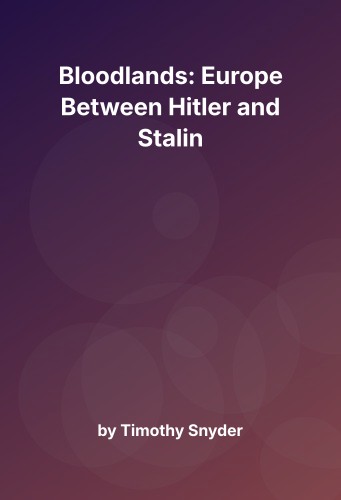Introduction
“Bloodlands: Europe Between Hitler and Stalin” by Timothy Snyder is a compelling historical account that delves into the atrocities committed in the geographical and political space between Nazi Germany and the Soviet Union during the 1930s and 1940s. The book offers a nuanced understanding of the mass murders and political strategies employed by two of history’s most notorious regimes. Snyder’s work is pivotal in emphasizing the sheer scale of human loss and the complex interplay of totalitarian ideologies.
Core Frameworks and Concepts
Snyder’s analysis is rooted in a comprehensive framework that examines the intersection of geographical, political, and ideological factors that contributed to the catastrophic loss of life in the “bloodlands.”
Geographical Context
The term “bloodlands” refers to the region encompassing present-day Poland, Belarus, Ukraine, the Baltic states, and parts of western Russia. This area became the epicenter of violence due to its strategic importance to both Hitler and Stalin. Similar to the analysis in “The Rape of Nanking” by Iris Chang, which explored the horrors of Japanese occupation in China, Snyder’s use of geographical context helps readers understand why certain areas became focal points of extreme violence.
Political Ideologies
Snyder juxtaposes the ideologies of Nazi Germany and the Soviet Union to highlight their commonalities and differences. Both regimes sought to reshape society through radical means, often resulting in unprecedented levels of state-sponsored violence. This analysis can be compared to Hannah Arendt’s “The Origins of Totalitarianism,” which explores the philosophical underpinnings of totalitarian regimes and their impact on society.
The Role of Leadership
The decisions made by Hitler and Stalin were instrumental in shaping the events in the bloodlands. Their leadership styles, characterized by paranoia and a relentless pursuit of ideological objectives, led to catastrophic policies. This aspect of leadership can be compared to Robert Caro’s “The Years of Lyndon Johnson,” which, although focused on a different historical figure, similarly analyzes how individual leadership styles can influence national policies.
Mechanisms of Mass Murder
Snyder meticulously details the mechanisms of mass murder, including the Holocaust, the Holodomor, and other mass executions. By examining these events, Snyder provides a framework for understanding how bureaucratic processes and dehumanization can facilitate large-scale atrocities. This analysis aligns with Daniel Goldhagen’s “Hitler’s Willing Executioners,” which explores the role of ordinary individuals in the execution of genocidal policies.
Human Stories and Testimonies
A significant aspect of Snyder’s work is his emphasis on personal narratives and testimonies, which bring a human dimension to the historical analysis. These stories serve as poignant reminders of the individual lives affected by the broader political forces. Similar to Svetlana Alexievich’s “Voices from Chernobyl,” Snyder’s inclusion of personal accounts highlights the lasting impact of historical events on real people.
Key Themes
1. The Intersection of Ideologies
Snyder explores how the conflicting ideologies of Nazi Germany and the Soviet Union led to a convergence of violence in the bloodlands. Both regimes viewed the region as crucial to their expansionist goals, with Hitler’s vision of Lebensraum clashing with Stalin’s collectivization efforts.
2. The Scale of Human Suffering
The book documents the staggering human cost of the policies enacted by both regimes. Snyder estimates that approximately 14 million civilians were murdered in the bloodlands, a figure that underscores the unprecedented scale of suffering during this period. This theme is echoed in works like “The Gulag Archipelago” by Aleksandr Solzhenitsyn, which chronicles the brutal realities of Soviet labor camps.
3. The Role of Bureaucracy
Snyder highlights the role of bureaucratic systems in facilitating mass murder. The efficiency and organization of these systems allowed for the systematic targeting and extermination of millions. This theme is reminiscent of the analysis in “Eichmann in Jerusalem” by Hannah Arendt, which examines the “banality of evil” and the role of ordinary individuals in executing genocidal policies.
4. Personal Narratives and Memory
The inclusion of personal stories is a powerful aspect of Snyder’s work, providing a human face to the historical events. These narratives serve as a reminder of the importance of memory in preserving the lessons of history. Similar to “Man’s Search for Meaning” by Viktor Frankl, which explores the psychological impact of surviving the Holocaust, Snyder’s work emphasizes the resilience of the human spirit.
5. The Impact of Totalitarianism
Snyder’s analysis of the totalitarian regimes in Nazi Germany and the Soviet Union underscores the dangers of unchecked power and ideological extremism. The book serves as a cautionary tale about the potential for history to repeat itself if the lessons of the past are not heeded. This theme resonates with George Orwell’s “1984,” which explores the pervasive influence of totalitarian control on individual freedom.
Final Reflection
“Bloodlands: Europe Between Hitler and Stalin” offers a profound and meticulously researched exploration of one of the darkest periods in modern history. By examining the intersection of geography, ideology, and leadership, Snyder provides valuable insights into the mechanisms of mass violence and the human capacity for both cruelty and resilience. The book’s emphasis on personal narratives and memory serves as a poignant reminder of the importance of preserving the lessons of history for future generations.
This analysis is not just relevant for historians but also offers critical insights for leaders and policymakers across domains. The themes of leadership, bureaucracy, and the impact of ideology are applicable in understanding contemporary issues of governance and ethical decision-making. The book prompts readers to reflect on the moral responsibilities of leadership and the potential consequences of unchecked power.
In synthesizing the lessons from “Bloodlands,” readers are encouraged to consider the broader implications of historical events on present-day challenges. Whether in the realms of politics, business, or social justice, the book serves as a powerful reminder of the need for vigilance, empathy, and a commitment to preventing the recurrence of past atrocities.

